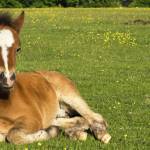Managing Club-Footed Conformation in Foals

In normal horses with well-maintained hooves, the angle of the hoof measures about 45 degrees on side view. Deviations to this ideal exist, and one of the most common is called club foot. A club foot is characterized by a hoof-wall angle that is too steep, and the abnormality might have other features, including a bulging coronary band, growth rings wider at the heel than the toe, and a dished or concave wall, especially near the toe. Unusual hoof growth is also a hallmark of a club foot.
Considered a flexural deformity of the coffin joint, a club foot results from shortening of the deep digital flexor tendon, which pulls up the heel and changes the angle of the pastern joint. Club foot may be found in foals or older horses, and the problem can be present from birth or acquired later in life. Most often, a horse has only one affected hoof, though some horses have more than one club foot.
Club feet in horses range from mild (affected hoof has an angle of up to 5 degrees greater than the contralateral hoof) to severe (very steep hoof angle, concave hoof wall, and a hoof-pastern angle that greatly varies from normal).
In newborn foals, club feet might have been caused by malpositioning of the fetus before birth, or exposure of the mare to various known or unknown substances or diseases that can cause birth defects. Treatment of mild cases may resolve after the foal is allowed to move around for a day or two. In more severe cases, treatment can include therapeutic stretching, splints, or bandaging.
According to Bryan Waldridge, D.V.M., M.S., staff veterinarian at Kentucky Equine Research, acquired club feet show up most often in foals that are between two and eight months old. Some mares repeatedly have foals with this problem, suggesting a genetic predisposition. Other foals develop contraction in one leg, possibly related to pain from overtrimming hooves, sole bruising from exercising on hard ground, or another injury.
Corrective trimming can be done to bring the hoof-pastern angle closer to normal, but this must be done in small increments and at frequent intervals. Some foals will need to have exercise restricted as this process is being carried out.
If therapeutic trimming doesn’t correct the problem, the foal becomes a candidate for surgery to cut the check ligament that attaches to the deep digital flexor tendon. This surgery must be coupled with specialized trimming and shoeing to support limb structures as they heal in the right configuration. Immediate post-surgical care involves limited hand-walking or turnout in a small paddock. The hoof should be trimmed about every two weeks, continuing to lower the heel by small increments until the proper hoof and pastern alignment is reached.








